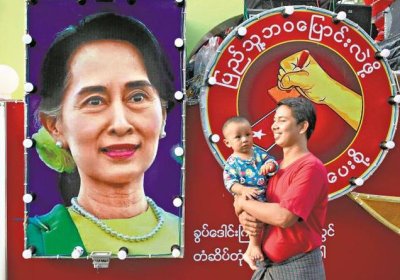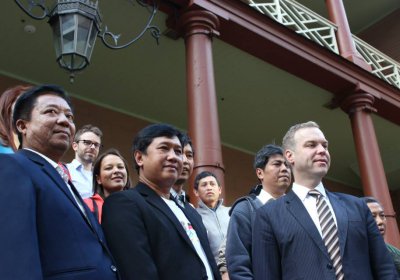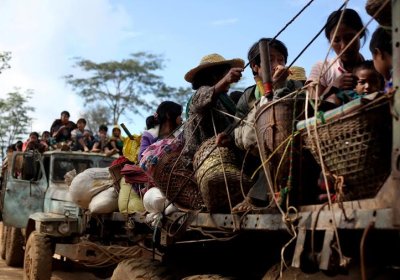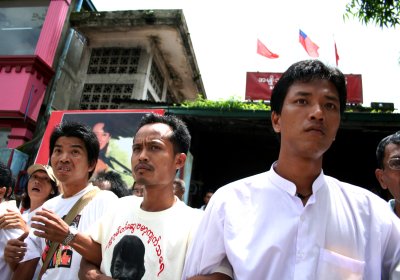Campaigning kicked off on September 8 for the first competitive elections in Myanmar (Burma) since the 1950s. The November 8 poll will pit the ruling Union Solidarity and Development Party (USDP) against more than 100 opposition parties, including Nobel laureate Aung San Suu Kyi’s National League for Democracy (NLD).
Myanmar’s military ceded power to a quasi-civilian government through 2010 elections that were boycotted by the NLD, ending a military dictatorship that spanned from 1962.
Myanmar
The toll of Australia's bipartisan anti-refugee policies in death and suffering is rising. In the past fortnight more than 3000 Rohingya refugees from Arakan state in Burma (Myanmar) have turned up on the shores of Thailand, Malaysia and Indonesia, having either swum ashore or been rescued by local fishing boat crews. An estimated 7000 more are trapped on boats that have been described as “floating coffins”.
One cannot but feel privileged and awed to meet three of Burma's “88 Generation” student uprising leaders: Min Ko Naing who has spent most of the years since 1988 uprising jailed by the Burmese military dictatorship for his opposition activities; Ko Jimmy, who spent 20 years as a political prisoner and who was recently thrown back into what he wryly describes as “our second home” for protesting against fuel price hikes; and Ko Ko Gyi who spent 17 years in prison for opposing the military regime.
Je yang camp, located a 30 minutes drive on often unpaved or rocky road from Laiza, the capital of rebels in Kachin State in northern Burma, accommodates about 8000 Internally Displaced Persons (IDPs).
The wild landscape around the camp suggests the scenery would have been far more stunning without the presence of humans.
Jani Alam, a 25-year-old, is walking slow and painfully. Having slightly swollen feet, this “exercise” is the only treatment available from 60-year-old traditional doctor, Guramia Saiyid.
Both Alam and Saiyad are stateless refugees from the Rohingya ethnic minority from Arakan state in western Burma. They now live in Malaysia.
Saiyad has lived in the country for 11 years, while Alam has arrived four months ago.
“In the past months, dozens of refugees arrived almost every day,” said 41-year-old Jamar Udin, a neighbor and also a Rohingya.
A protest was held outside the Department of Foreign Affairs and Trade in Sydney on March 19, to oppose the controversial state visit by the Myanmar president Thein Sein.
Prime Minister Julia Gillard met with Thein and announced a $20 million two-year aid program, as well as the posting of a resident military attache and a trade commissioner in Yangon.
Protesters representing the Rohingya, Karen and Kachin communities demanded the Australian government address the gross human rights abuses before business and military deals are made.
Photos by Peter Boyle.
There are wildly divergent estimates of the death toll from ethnic and religious violence in the Burmese state of Arakan.
Mainstream media reports and the Burmese government are claiming that fewer than 100 people have been killed in violence they describe as clashes between the Buddhist Rakhine majority and Muslim Rohingya minority communities.
However, Rohingya sources estimate thousands of deaths from a planned campaign of violent ethnic cleansing by Burmese government forces. Rohingya sources say the regime has been instigating Rakhine mob violence as part of their campaign.
Struggle For Freedom: Aung San Suu Kyi
By Jesper Bengtsson
Fourth Estate, 2011, 308 pages, $35 (pb)
Aung San Suu Kyi’s entry into political activism in Burma in 1988 quickly met the fate of so many other pro-democracy opponents of the Burmese military dictatorship — decades of arrest and harassment.
Suu Kyi has been under house arrest for 15 of the past 21 years. But, as Jesper Bengtsson’s biography of the 65-year-old Suu Kyi shows, her resistance and courage, like that of so many other Burmese, has not faltered.
Citizens of the Union of Myanmar, formerly and more commonly known as Burma, went to the polls on April 1 for crucial by-elections that have generated much attention.
The by-elections, to fill a few dozen seats in the 664-member parliament, elected leading democracy figure Aung San Suu Kyi to the constituency of Kawhmu, sending the democracy activist into the lower house of parliament.
Kawhmu is a small, rural farming town with no paved roads, electricity or running water. It is just one of many impoverished towns that litter Myanmar.
Early in January, the Sa-Ka-Kha-9 military division based near the ancient Falom village seized about 50 houses and a mosque that had been built at the village's edge. It is one of 36 that are Rohingyan (a predominantly Muslim ethnic minority) in the Kyauktaw township in the western Burmese Arakan state along the Kaladan River.
These lands had been re-bought from the military by Falom villagers. For 17 years, until re-buying the land, the village consisted of 280 houses and some farm lands. The mosque was demolished by the military in 1995.
Burma’s November 7 elections — held under an undemocratic constitution in an atmosphere of repression and with the result crudely rigged — have been overshadowed by the release from house arrest of opposition National League for Democracy (NLD) leader Aung San Suu Kyi on November 13.
Thousands of supporters lined the streets to her house and flocked to NLD offices to hear her speak.
Suu Kyi’s release has been compared to that of Nelson Mandela in 1990. However, unlike Mandela, Suu Kyi was not released from detention by a regime seeking negotiations.
“The whole process was a fake!”, said Khin Maung Swe, a 68-year-old leader of the National Democratic Force (NDF), a breakaway from the National League for Democracy (NLD) led by Aung San Suu Kyi.
- Previous page
- Page 4
- Next page










